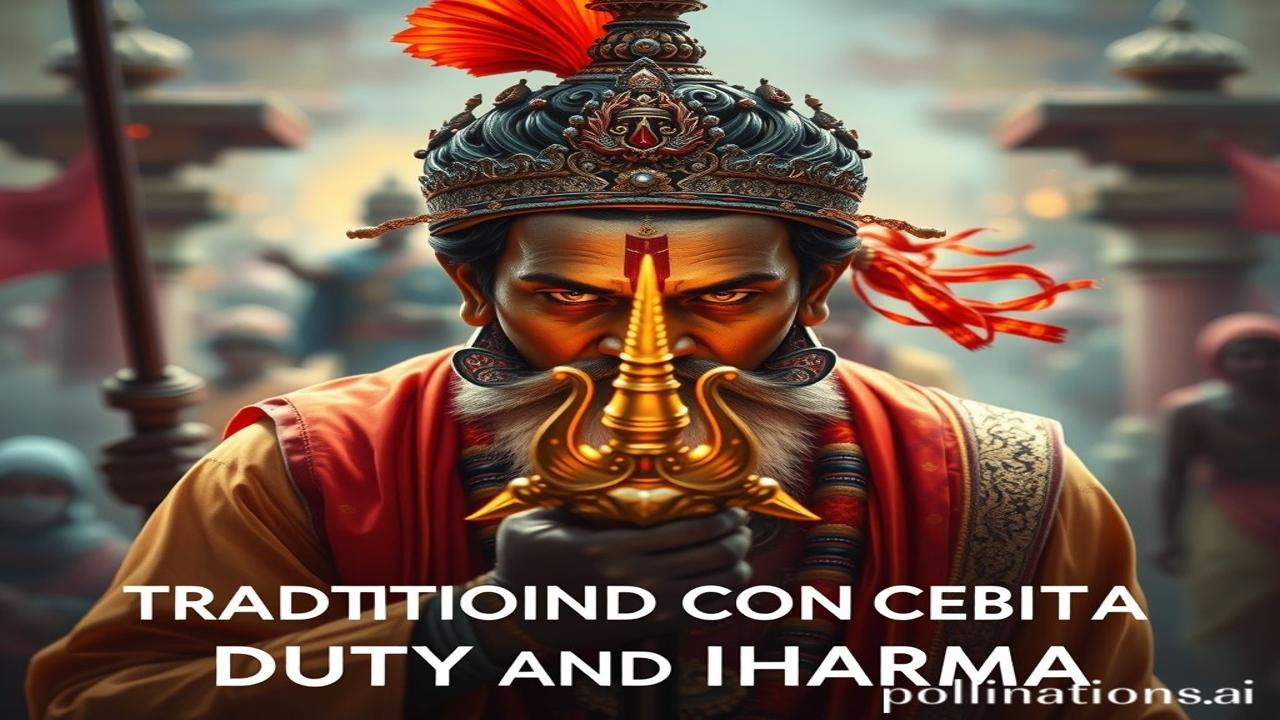Waqt Ki Dhool Mein Chhupi Dharm Ki Awaaz: Duty and Dharma, Then and Now
Kabhi socha hai, agar hum apne purano ke panno ko palte toh kya milega? Just imagine, 5000 saal pehle ki Dharti pe, jab yeh concept of ‘Duty’ aur ‘Dharma’ shuru hua tha, life kaise thi? What if we could listen to the whispers of the past, to understand what these words truly mean and how they still resonate in our hearts today? Waqt ki dhool mein kuch kahaniyan chhupi hain, aur aaj, hum unhi kahaniyon ko dhoondhne niklenge.
Dharohar: Roots in History and Culture
So, what exactly are ‘Duty’ and ‘Dharma’? Simply put, they are not just rules, but the very foundation of ancient Indian society. ‘Dharma’ is much more than religion; it’s about righteousness, cosmic order, and your personal duty to uphold that order. ‘Duty,’ on the other hand, is your specific responsibility – towards your family, your community, and even the cosmos.
These concepts aren’t new. They originated thousands of years ago, with the Vedas and Upanishads. Think about it – yeh sab concepts tab develop hue jab humare rishi-muni jungles mein baithe meditation karte the, trying to understand the universe. The Bhagavad Gita is one of the most important texts elaborating on ‘Dharma’ and ‘Duty,’ primarily through the dialogue between Arjuna and Krishna on the battlefield of Kurukshetra. Krishna urged Arjuna to fulfill his dharma as a warrior, regardless of personal feelings.
Why is this important in our history? Because it shaped the social structure, political ideologies, and personal ethics for generations. The concept of ‘Rajadharma’ (the dharma of a ruler) guided kings and emperors. The varnashrama system, while controversial, was also based on the idea of specific ‘dharmas’ for different social classes. These were not just suggestions; they were the blueprint for a well-ordered society, with each individual playing a crucial role.
ज़मीनी सच: Life Aur Logo Ki Kahani
Let’s dive into the real lives of people who lived by these principles. Picture this:
Raja Vikramaditya in his court: Woh hamesha ‘Rajadharma’ follow karte the – protecting his subjects, dispensing justice fairly. He wouldn’t rest until every complaint was heard and resolved. His duty was to the people.
Ma Rukmini ne aaj naye kapde pehne: Kyunki mandir mein utsav tha. For her, dharma meant devotion and participation in community celebrations, strengthening social bonds. Her duty was to keep the traditions alive.
A farmer toiling in the fields: His dharma was to provide for his family and his community. He understood that his duty was to nourish the land, even if it meant backbreaking labor. His tools were simple – a plow, a bull, and unwavering faith.
A warrior on the battlefield: He knew he might not return home, but he had to follow his dharma – to defend his kingdom and protect the innocent. The fear was real, but his duty was stronger.
These stories, real or imagined, show how ‘Dharma’ and ‘Duty’ were interwoven into the fabric of everyday life. People didn’t just talk about these concepts; they lived them.
धरोहर और पहचान: Echoes in Modern India
Today, ‘Dharma’ and ‘Duty’ still echo in various aspects of Indian life. We see it in:
- Family values: The concept of respecting elders and caring for family members remains strong. It’s our duty to our parents and our dharma to uphold familial bonds.
- Festivals and rituals: Festivals like Diwali, Holi, and Durga Puja are not just celebrations; they are reminders of our cultural heritage and the importance of dharma. We perform our duty by participating in these traditions.
- Yoga and meditation: The practice of yoga, rooted in ancient Indian philosophy, emphasizes self-discipline and living in accordance with dharma.
- Social service: Many NGOs and individuals dedicate their lives to helping others, fulfilling their duty towards society and embodying the principles of dharma.
This connection to Bharatiyata and modern identity is crucial. Even though modern India is evolving rapidly, the core values of ‘Dharma’ and ‘Duty’ remain integral to our sense of self and our responsibility towards one another.
मजेदार तथ्य या भ्रम-भंजक: Cracking the Code
Myth: Log samajhte hain ki ‘Dharma’ ka matlab sirf religion hai.
Truth: ‘Dharma’ is way broader than religion. It’s about cosmic order, righteousness, and your personal responsibility to uphold those values. It’s not just about going to a temple or following rituals; it’s about how you live your life.
Fun Fact: Did you know that in ancient times, kings had a specific advisor called a Dharmadhikari? Their sole purpose was to ensure the king followed ‘Rajadharma’ and ruled justly. Talk about accountability!
दृश्य और भावनाएं: The Sensory Experience
Imagine walking through the ancient temple of Khajuraho. The air smells of incense and sandalwood. The walls, carved with intricate sculptures, feel warm to the touch. The sounds of chanting echo in the inner sanctum. This is a space where the concept of dharma comes alive – where art, religion, and life intertwine. The visual beauty evokes devotion, the sensory experience invokes a sense of belonging, and the overall atmosphere strengthens our connection to our cultural roots.
अंतिम विचार या उद्धरण: Leaving You with Insight
As we conclude this journey, let’s remember that ‘Dharma’ and ‘Duty’ are not just ancient concepts; they are living principles that continue to guide us. They remind us of our responsibility to ourselves, to our community, and to the world.
As the Bhagavad Gita says: “Yada yada hi dharmasya glanir bhavati bharata, abhyutthanam adharmasya tadatmanam srjamyaham.” This means, “Whenever there is a decline in dharma and an upsurge in adharma, then I manifest Myself.” It is a constant reminder that upholding dharma is an ongoing process, a continuous striving towards righteousness.
So, let’s carry this understanding with us, weaving these ancient values into our modern lives, making India, and the world, a better place, one action at a time.
